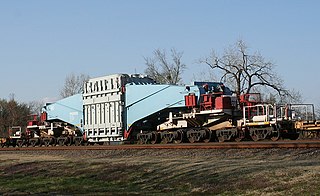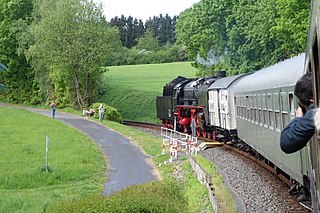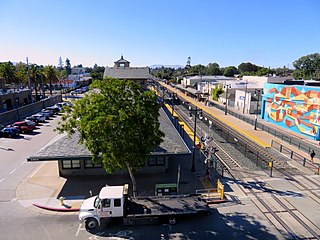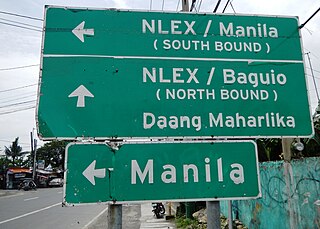
Intermodal freight transport involves the transportation of freight in an intermodal container or vehicle, using multiple modes of transportation, without any handling of the freight itself when changing modes. The method reduces cargo handling, and so improves security, reduces damage and loss, and allows freight to be transported faster. Reduced costs over road trucking is the key benefit for inter-continental use. This may be offset by reduced timings for road transport over shorter distances.

A loading gauge is a diagram or physical structure that defines the maximum height and width dimensions in railway vehicles and their loads. Their purpose is to ensure that rail vehicles can pass safely through tunnels and under bridges, and keep clear of platforms, trackside buildings and structures. Classification systems vary between different countries, and gauges may vary across a network, even if the track gauge is uniform.

A clearance car is a type of railroad car in maintenance of way service. Its purpose is to check the clearances around the tracks and ensure that trains conforming to the railroad's standard loading gauge or dynamic envelope will not encounter any obstruction. Additionally, by measuring the actual clearances along a route, the railroad can determine whether outsize loads can be accommodated along that route, and the largest size feasible.
Standards for Interstate Highways in the United States are defined by the American Association of State Highway and Transportation Officials (AASHTO) in the publication A Policy on Design Standards: Interstate System. For a certain highway to be considered an Interstate Highway, it must meet these construction requirements or obtain a waiver from the Federal Highway Administration.

A Schnabel car or Schnabel wagon is a specialized type of railroad freight car. It is designed to carry heavy and oversized loads in such a way that the load makes up part of the car. The load is suspended between the two ends of the cars by lifting arms; the lifting arms are connected to an assembly of span bolsters that distribute the weight of the load and the lifting arm over many wheels.

A structure gauge, also called the minimum structure outline, is a diagram or physical structure that sets limits to the extent that bridges, tunnels and other infrastructure can encroach on rail vehicles. It specifies the height and width of station platforms, tunnels and bridges, and the width of the doors that allow access to a warehouse from a rail siding. Specifications may include the minimum distance from rail vehicles to railway platforms, buildings, lineside electrical equipment cabinets, signalling equipment, third rails or supports for overhead lines.

In road transport, an oversize load is a load that exceeds the standard or ordinary legal size and/or weight limits for a truck to convey on a specified portion of road, highway, or other transport infrastructure, such as air freight or water freight. In Europe, it may be referred to as special transport or heavy and oversized transportation. There may also be load-per-axle limits. However, a load that exceeds the per-axle limits but not the overall weight limits is considered overweight. Examples of oversize/overweight loads include construction machines, pre-built homes, containers, and construction elements.

A predecessor to the Class I Delaware and Hudson Railway, the 1820s-built Delaware and Hudson Canal Company Gravity Railroad('D&H Gravity Railroad') was a historic gravity railroad incorporated and chartered in 1826 with land grant rights in the US state of Pennsylvania as a humble subsidiary of the Delaware and Hudson Canal and it proved to contain the first trackage of the later organized Delaware and Hudson Railroad. It began as the second long U.S. gravity railroad built initially to haul coal to canal boats, was the second railway chartered in the United States after the Mohawk and Hudson Rail Road before even, the Baltimore and Ohio. As a long gravity railway, only the Summit Hill and Mauch Chunk Railroad pre-dated its beginning of operations.

A flatbed truck is a type of truck the bodywork of which is just an entirely flat, level 'bed' with no sides or roof. This allows for quick and easy loading of goods, and consequently they are used to transport heavy loads that are not delicate or vulnerable to rain, and also for abnormal loads that require more space than is available on a closed body. Flatbed trucks can be either articulated or rigid.

San Mateo station is the northernmost of the three Caltrain stations in San Mateo, California. It is in downtown San Mateo.

The Illinois Central Stone Arch Railroad Bridges are a trio of limestone railroad bridges in the city of Dixon, Illinois, United States. The bridges were constructed between 1852 and 1855 as the Illinois Central Railroad laid its first rail lines across the state of Illinois. They were designed by Robert F. Laing for Laing and Douglas Construction Company, a railroad company contractor during the 1850s. Though each limestone bridge is similar in design, they each have different clearances ranging between 12 and 15 feet. The bridges remained in use by the railroad until 1985, and the three bridges were added to the U.S. National Register of Historic Places in 1987.

A well car, also known as a double-stack car, is a type of railroad car specially designed to carry intermodal containers used in intermodal freight transport. The "well" is a depressed section that sits close to the rails between the wheel trucks of the car, allowing a container to be carried lower than on a traditional flatcar. This makes it possible to carry a stack of two containers per unit on railway lines wherever the structure gauge assures sufficient clearance. The top container is secured to the bottom container either by a bulkhead built into the car — possible when bottom and top containers are the same dimensions, or through the use of inter-box connectors (IBC). Four IBCs are needed per well car. In the terminal there are four steps: unlock and lift off the top containers of an inbound train, remove the bottom containers, insert outbound bottom containers, lock assembly after top containers emplaced. Generally this is done car-by-car unless multiple crane apparatus are employed.

In the United States, road signs are, for the most part, standardized by federal regulations, most notably in the Manual on Uniform Traffic Control Devices (MUTCD) and its companion volume the Standard Highway Signs (SHS).

Double-stack rail transport is a form of intermodal freight transport in which railroad cars carry two layers of intermodal containers. Invented in the United States in 1984, it is now being used for nearly seventy percent of United States intermodal shipments. Using double stack technology, a freight train of a given length can carry roughly twice as many containers, sharply reducing transport costs per container. On United States railroads special well cars are used for double-stack shipment to reduce the needed vertical clearance and to lower the center of gravity of a loaded car. In addition, the well car design reduces damage in transit and provides greater cargo security by cradling the lower containers so their doors cannot be opened. A succession of larger container sizes have been introduced to further increase shipping productivity in the United States.

Xerxes' pontoon bridges were constructed in 480 BC during the second Persian invasion of Greece upon the order of Xerxes I of Persia for the purpose of Xerxes' army to traverse the Hellespont from Asia into Thrace, then also controlled by Persia.

The Norfolk Southern–Gregson Street Overpass, also known as the 11-foot-8 Bridge, is a railroad bridge in Durham, North Carolina, United States. Built in 1940, the bridge allows passenger and freight trains to cross over South Gregson Street in downtown Durham and also functions as the northbound access to the nearby Durham Amtrak station.

The Montague Street Bridge is a railway bridge in South Melbourne, Australia, an inner suburb of Melbourne. The bridge is located at 83 Montague Street, between Woodgate Street and Gladstone Lane.

Road signs in the Philippines are regulated and standardized by the Department of Public Works and Highways (DPWH). Most of the signs reflect minor influences from American and Australian signs but keep a design closer to the Vienna Convention on Road Signs and Signals, to which the Philippines is an original signatory. The Philippines signed the convention on November 8, 1968, and ratified it on December 27, 1973.

Bridge strike or tunnel strike is a type of transport accident in which a vehicle collides with a bridge, overpass, or tunnel structure. Bridge-strike road accidents, in which an over-height vehicle collides with the underside of the structure, occur frequently and are a major issue worldwide. In waterways, the term encompasses water vessel–bridge collisions, including bridge span and support structure collisions.
In civil engineering, clearance refers to the difference between the loading gauge and the structure gauge in the case of railroad cars or trams, or the difference between the size of any vehicle and the width/height of doors, the width/height of an overpass or the diameter of a tunnel as well as the air draft under a bridge, the width of a lock or diameter of a tunnel in the case of watercraft. In addition, there is the difference between the deep draft and the stream bed or sea bed of a waterway.


















